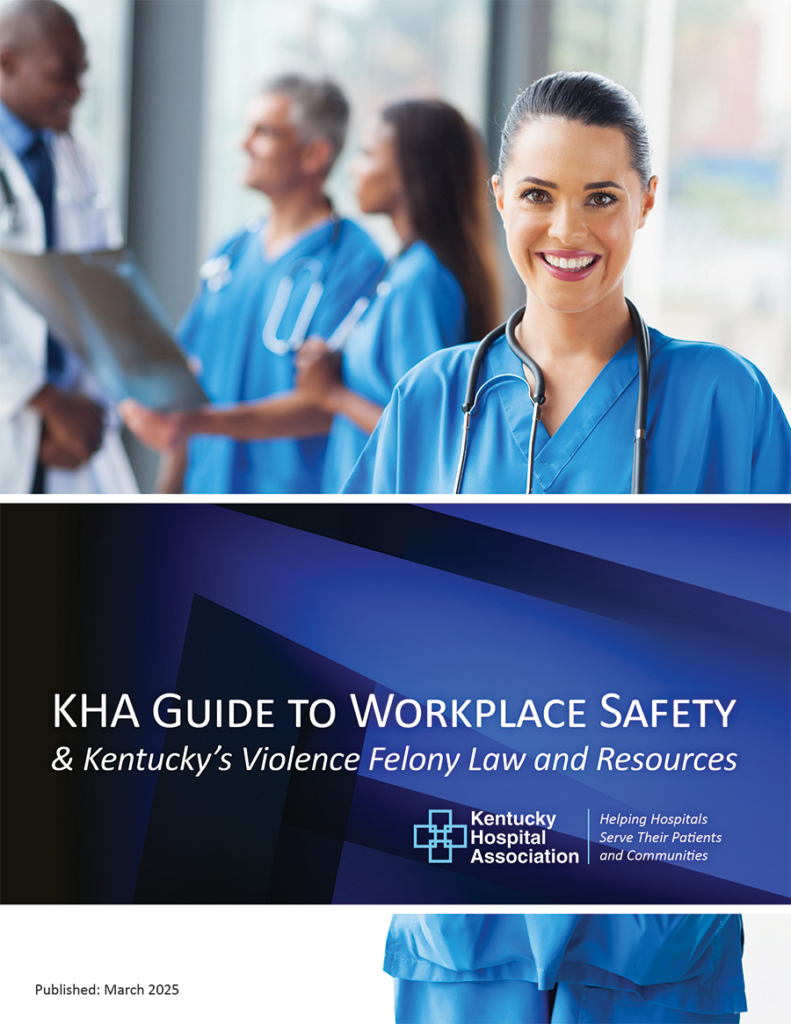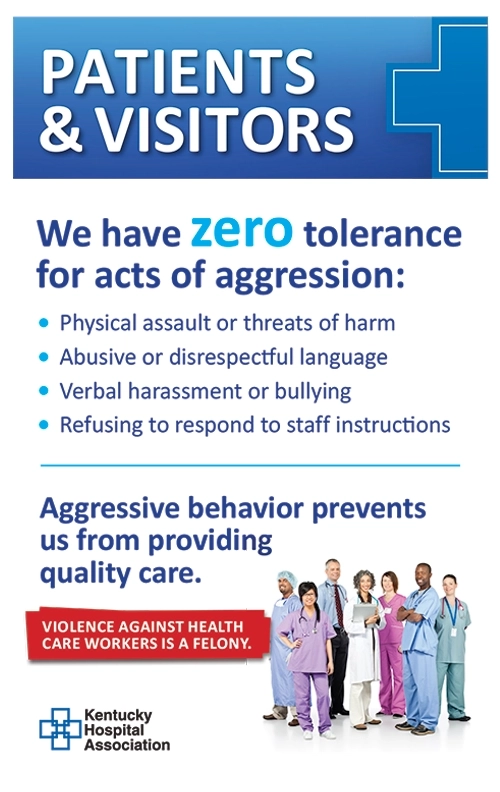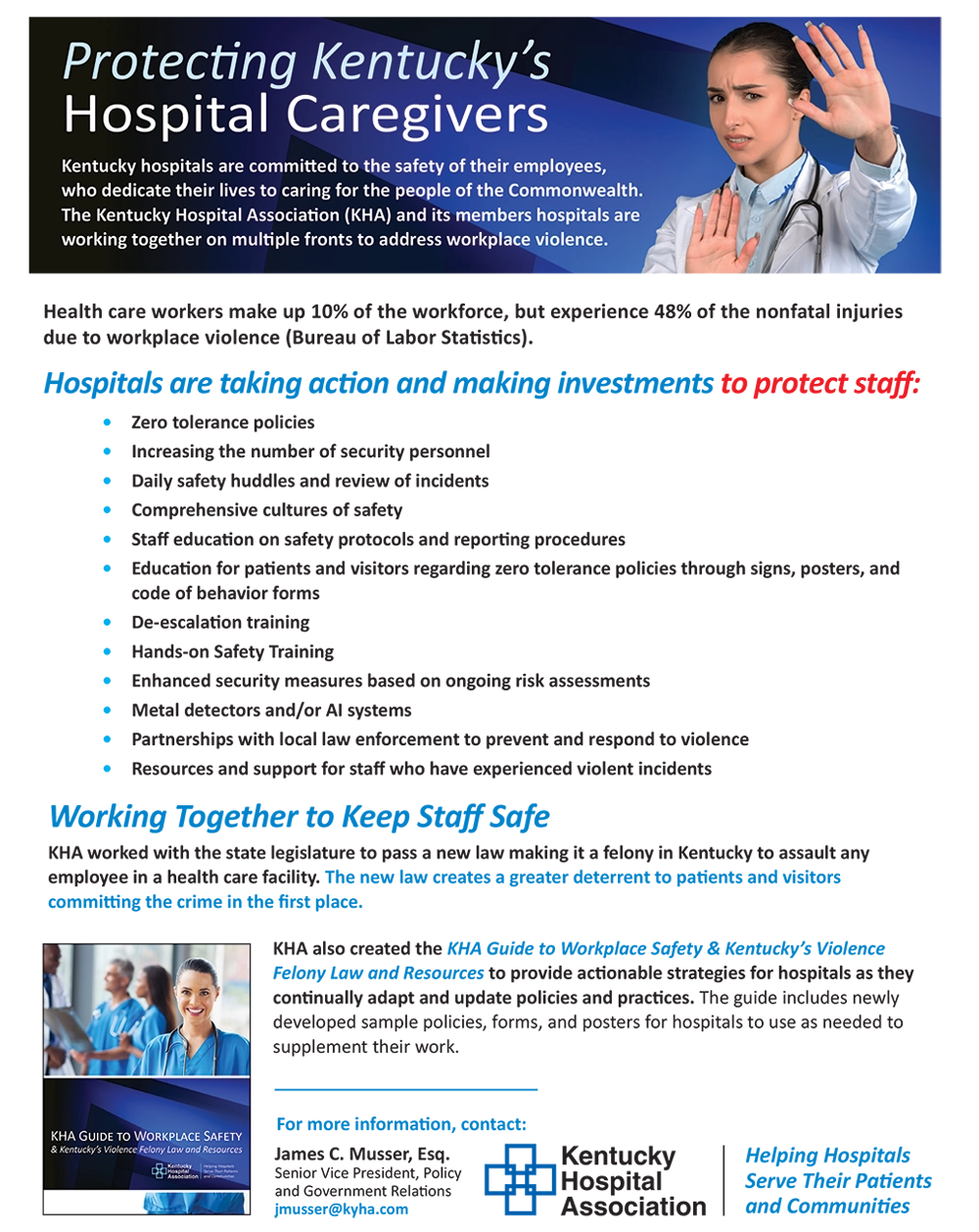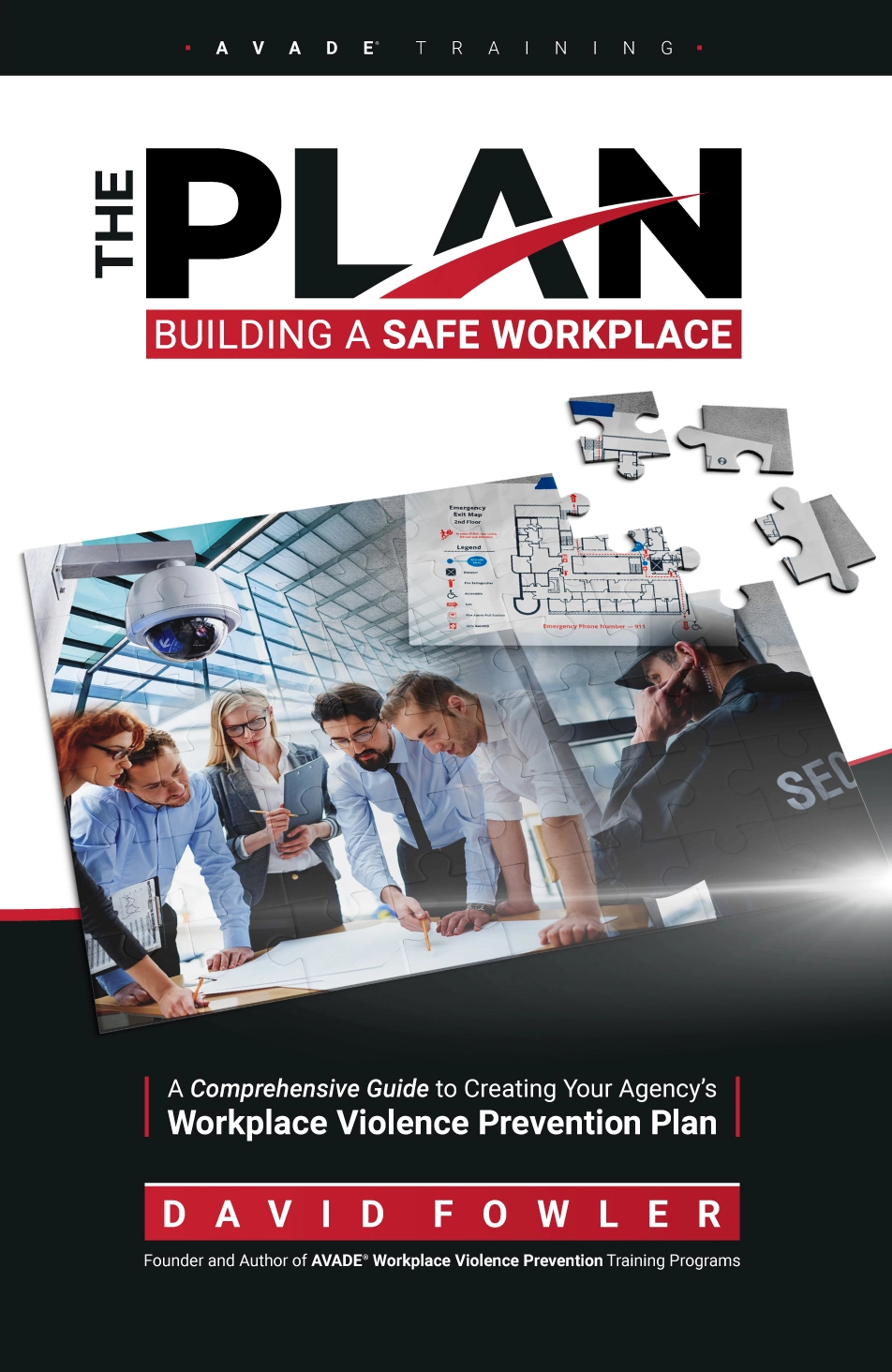Workplace Violence Prevention
According to Time magazine, “data shows American health care workers now suffer more nonfatal injuries from workplace violence than workers in any other profession, including law enforcement.” (Time, August 7, 2023)
The following statistics illustrate the severity of this crisis (Healthcare Finance, June 2023):
- 40% of healthcare workers have experienced at least one incident of workplace violence within the past two years.
- 60% of healthcare workers who experienced violence identified themselves as bedside nurses.
- 34% of those nurses reported emotional or verbal violence.
- 66% experienced physical or sexual violence. Survey respondents who provided details:
- 51% said they dealt with a combative patient.
- 62% of respondents endured scratching, biting and hitting while dealing with a combative patient
- 21% said the patient threw objects
- 14% indicated sexual assault or harassment
Resources
Protecting Kentucky’s Hospital Caregivers
KHA and its members hospitals are working together on multiple fronts to address workplace violence. (2025)

KHA Guide to Workplace Safety
This guide includes an overview of the prevalence and impact of workplace violence, risk factors, and actionable strategies; and a review of Kentucky’s felony protection statute. (2025)

Workplace Violence Awareness Posters
KHA Members: Click here to access full-size versions of KHA’s Workplace Violence Prevention posters in PDF format, for use in your hospital.
Protect Hospital Caregivers from Workplace Violence
Health care professionals keep all of us safe. We need to return the favor. Violence against health care workers is never acceptable. (2023)
View Online | Download
AVADE® Workplace Violence Prevention Training
“AVADE is an awesome experience. AVADE – The future of healthcare workplace violence prevention.”
“AVADE is great and comprehensive. It was born out of healthcare and is tailored to healthcare. That is what makes it stand apart from the rest.”
“AVADE is real world violence education, prevention and mitigation and not just in the workplaces but in the life places!”
“AVADE is great! Every nurse should have this training!”
“David and Genelle are the greatest teachers I’ve ever worked with. Their teaching keeps you completely immersed in all aspects of the class. Their passion and drive to keep staff, patients and everyday people safe is contagious. I can’t wait to come back.”
“AVADE training is a game changer. It will change the entire culture of your facility.”
“I have experienced several de-escalation programs. This (AVADE) is by far the best.”
Jenni, Behavioral Health Unit Manager, Owensboro Health Regional Hospital
Other Resources
- Assault Law – KRS 508.025
- Safety Assessment & Training Laws – KRS 216.701-709
(note exceptions in KRS 216.703(3))- .701 Definitions for chapter.
- .703 Cabinet for Health and Family Services to establish guidelines for developing workplace safety assessment — Cabinet to audit health facilities for compliance — Standards for compliance.
- .705 Health facilities to develop and execute workplace safety assessment — Requirements.
- .707 Annual violence prevention training — Guidelines — Requirements — Basic protective skills competency test for health care workers.
- .709 Reporting system for acts of workplace violence — Recordkeeping — Procedures to follow up with and support victims of workplace violence.
American Organization for Nursing Leadership
An American Nurses Association study found that over a three-year period, 25 percent of surveyed registered nurses and nursing students reported being physically assaulted by a patient or a patient’s family member. 93% of all assaults come from patients or customers. Healthcare systems need to protect their staff. UCHealth developed a course that educated frontline staff on de-escalation techniques. During the measurement period following the deployment of the course, they have seen a 34% decrease in workplace violence. Now you can equip your staff with tools to recognize, report and de-escalate potential or actual threats of workplace violence.
Building a Safe Workplace and Community: Violence Mitigation in a Culture of Safety
This issue brief examines how hospitals’ violence mitigation efforts can fit effectively into an organization’s culture of safety strategy. The brief includes thought provoking questions to facilitate discussion of how violence mitigation can be integrated seamlessly into the larger framework of patient and worker safety initiatives, supporting an overall culture of safety. It also explores strategies that leaders could take to best support a culture that mitigates violence as part of larger enterprise efforts.
AHA/FBI Collaboration
The AHA and FBI released resources and webpage on mitigating targeted violence in health care settings. The AHA partnered with the FBI’s Behavioral Analysis Unit to promote violence prevention strategies and address the escalating threats and acts of targeted violence against health care facilities and the workforce. Through this partnership, the AHA will offer a full suite of resources for hospitals and health systems to implement threat assessment and threat management principles or enhance their existing efforts.
Hospitals Against Violence Initiative
The Hospitals Against Violence Initiative (HAV) is sharing examples and best practices with the field, with a particular emphasis on youth violence prevention, workplace violence prevention and combatting human trafficking.
Learn More
- Fact Sheet: Workplace Violence and Intimidation, and the Need for a
Federal Legislative Response - Building a Safe Workplace and Community: Mitigating the Risk of Violence
- Video: Hospitals Can Be Part of the Solution
- OSHA Guidelines for Preventing Workplace Violence for Healthcare and Social Service Workers (PDF)
The Guidelines describe the five components of an effective workplace violence prevention program, with extensive examples. - Hospital eTool Workplace Violence Checklist – This is an example of a checklist that an employer might use or modify to help identify potential workplace violence problems.
- Hospital eTool Workplace Violence Incident Report Form – This is an example of a form which an employer might use or modify to help report a potential workplace violence problem.
- Health Care Workplace Violence
- OSHA Enforcement
- OSHA Guidance
- Workplace Violence Safety and Health TOPICS
- Health Care Wide Hazards: Workplace Violence – This is a set of OSHA eTools for the hospital setting. It contains a variety of health care setting specific sections.
- Additional Search and OSHA Alliance Resources
- Violence on the Job
These videos and case studies discuss practical measures for identifying risk factors for violence at work, and taking strategic action to keep employees safe. - NIOSH on Health Care Workers
- NIOSH on Occupational Violence
- NIOSH on Stress at Work
- NIOSH on EMS Workers
- NIOSH on Hazardous Drug Exposures in Health Care
- NIOSH on Health and Safety Practices of Health Care Workers
- Workplace Violence Prevention Resources
- The Joint Commission’s Summary Regarding Revised Workplace Violence Prevention Standards for Hospitals: A Major Step Forward Toward Improved Quality and Safety
- R3 Report: Requirement, Rationale, Reference – Workplace Violence Prevention Standards
- Workplace Violence Training Programs for Health Care Workers: An Analysis of Program Elements (SAGE Journals)
- Active Shooter Planning and Response in a Healthcare Setting (FBI.gov)
- What to Do If There’s an Active Shooter at Your Healthcare Facility (Nurses Service Organization)
- Helping Victims of Mass Violence and Terrorism Toolkit (US Office for Victims of Crime)




